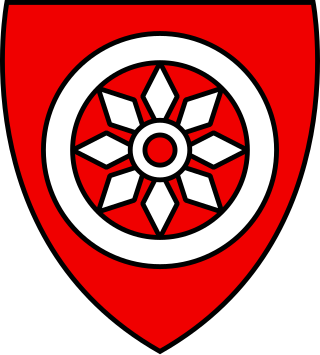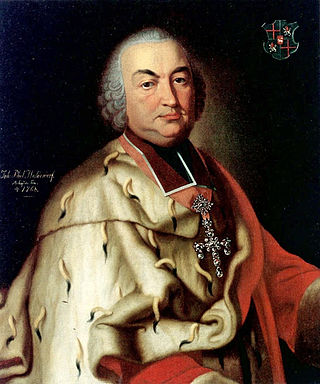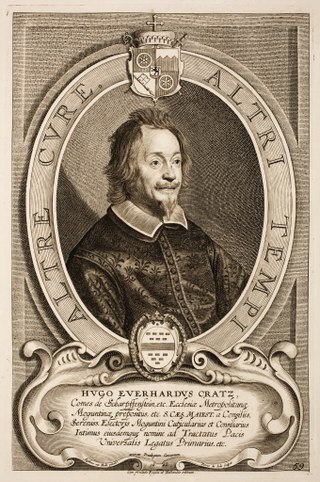
Philipp von Rothenstein (d. 1604) was briefly the Prince-Bishop of Worms in 1604.

Philipp von Rothenstein (d. 1604) was briefly the Prince-Bishop of Worms in 1604.

The Prince-Bishopric of Würzburg was an ecclesiastical principality of the Holy Roman Empire located in Lower Franconia, west of the Prince-Bishopric of Bamberg. Würzburg had been a diocese since 743. As established by the Concordat of 1448, bishops in Germany were chosen by the canons of the cathedral chapter and their election was later confirmed by the pope. Following a common practice in Germany, the prince-bishops of Würzburg were frequently elected to other ecclesiastical principalities as well. The last few prince-bishops resided at the Würzburg Residence, which is one of the grandest Baroque palaces in Europe.
Schönborn may refer to:

The House of Schönborn[ˈʃøːnbɔrn] is the name of an ancient noble and mediatised formerly sovereign family of the former Holy Roman Empire.

Johann Philipp von Schönborn was the Archbishop-Elector of Mainz (1647–1673), the Bishop of Würzburg (1642–1673), and the Bishop of Worms (1663–1673).

St Peter's Cathedral is a Roman Catholic church and former cathedral in Worms, southern Germany.

The Elector of Mainz was one of the seven Prince-electors of the Holy Roman Empire. As both the Archbishop of Mainz and the ruling prince of the Electorate of Mainz, the Elector of Mainz held a powerful position during the Middle Ages. The Archbishop-Elector was president of the electoral college, archchancellor of the empire, and the Primate of Germany as the papal legate north of the Alps, until the dissolution of the empire in 1806.

Johann Philipp von Walderdorff was the Archbishop-Elector of Trier from 1756 until 1768, and the Prince-Bishop of Worms from 1763 until 1768.

Würzburg Cathedral is a Roman Catholic cathedral in Würzburg in Bavaria, Germany, dedicated to Saint Kilian. It is the seat of the Bishop of Würzburg and has served as the burial place for the Prince-Bishops of Würzburg for hundreds of years. With an overall length of 103 metres, it is the fourth largest Romanesque church building in Germany, and a masterpiece of German architecture from the Salian period. Notable later additions include work by Tilman Riemenschneider and Balthasar Neumann. The cathedral was heavily damaged by British bombs in March 1945 but rebuilt post-World War II.

Lothar Friedrich von Metternich-Burscheid was the Bishop of Speyer from 1652 to 1675 and also Archbishop of Mainz and Bishop of Worms from 1673 to 1675.

Philipp Christoph von Sötern was the Prince-Bishop of Speyer from 1610 to 1652 and the Archbishop-Elector of Trier from 1623 to 1652.
The Prince-Bishopric of Naumburg-Zeitz was a medieval diocese in the central German area between Leipzig in the east and Erfurt in the west. The seat of the bishop was Zeitz Cathedral in Zeitz from 968 and 1029 and Naumburg Cathedral in Naumburg between 1029 and 1615. It was dissolved in the wake of the Reformation. The Bishopric of Zeitz-Naumburg encompassed the four archdeaconries of Naumburg, Zeitz, Altenburg and "trans Muldam".

Johann Philipp Anton Freiherr von und zu Franckenstein, born in Forchheim on 27 March 1695, appointed in 1743 as Vicar-General of Mainz, was from 1746 to 1753 ruling Prince-bishop of Bamberg.
Philipp von Rothenstein was the Prince-Bishop of Worms from 1596 to 1604. He was appointed bishop on July 15, 1596, and died in office on March 21, 1604.

Hugo Eberhard Kratz von Scharfenstein was the Prince-Bishop of Worms from 1654 to 1663.
Philipp Wirich Lorenz von Daun zu Sassenheim und Callenborn was a German prelate of the Roman Catholic Church. He served as Auxiliary Bishop of Passau from 1757 until his death in 1763.
Gregor Helfenstein (1559–1632) was a Roman Catholic prelate who served as Auxiliary Bishop of Trier (1599–1632).

Johann Philipp Kratz von Scharffenstein was a German nobleman and field marshal, who fought during the course of the Thirty Years' War. He served with distinction in forces of both the Catholic League and Holy Roman Empire. His poor relationship with the Imperial generalissimo Albrecht von Wallenstein frustrated his plan of becoming the supreme commander of the League's forces. Embittered by this he defected to Sweden, where he attained the rank of field marshal. He was captured at the Battle of Nördlingen in 1634 and executed for treason a year later.